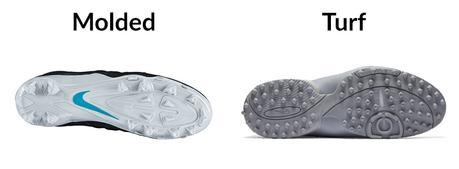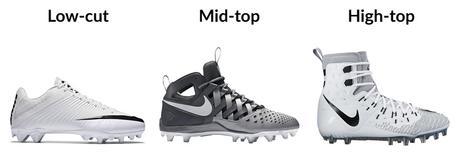Lacrosse, in essence, is a fairly straightforward sport that requires a few vital pieces of equipment. The most important of which are the lacrosse stick (or crosse) and the ball. Everything else is mostly meant for protection against injury. That’s not to say you shouldn’t wear protective gear, however, because it should always be on when playing. Then you have the lacrosse cleats. Sure, playing bare bones, you don’t necessarily need to have cleats to play lacrosse, but they sure are useful for providing traction as you dart up and down the field. But choosing the right cleats for you will take a bit of time and research. If you have no idea what you’re looking for yet, read through our handy guide on how to choose lacrosse cleats. It should be more than enough to get you started down the right path. Now, let’s get started!
How to Choose Lacrosse Cleats
What Are Lacrosse Cleats For?
Lacrosse cleats have one major role and that’s to keep you grounded no matter what the field conditions are like. Just like other field sports (baseball, soccer, and football), cleats provide the adequate traction needed for fast, intense movements and turns without having you slip. But lacrosse cleats are nothing like baseball or soccer cleats. They are comparable to football cleats, but some key differences are what set them apart from each other. Whereas football cleats require rigid sidewalls and high ankle support for protection against collisions, lacrosse cleats are more lightweight and breathable while protection is not stressed nearly as much.
Choosing the Right Type of Cleat
To understand how lacrosse cleats are designed, let’s take a look at what you’re running on. Lacrosse is played on large fields of grass, and so cleats come with studs on the bottom of the sole that can dig into grass or mud to provide stability.
For natural fields, molded studs are either made of rubber or plastic, usually with 4-6 large studs in the heel and around 8-12 in the front. Some cleats may have detachable studs that screw on and off. For those playing on turf fields, use specially made turf cleats which have dozens of smaller, protruding rubber nubs.
What type of cleat you choose is largely up to you, but having a pair of turf cleats for training could be a wise choice if you play often.

Choosing the Right Cut Length
The next thing you’ll want to consider while learning how to choose lacrosse cleats is the right cut length. How high should the cleat rise above the ankle, or do you want it to sit below the ankle? There are three options to choose from, each with its own pros and cons. There are low-cut, mid-top, or high-top cleats available.
Low-cut – Low-cuts offer the most mobility for those that have to move around the field a lot. However, there is minimal to no ankle support.
Mid-top – Mid-tops provide a good balance between mobility and ankle support, although it excels at neither.
High-top – High-tops offer the most ankle support and protection, specially made for the player who requires lots of stability. However, you’ll have less mobility as a result.

How to Fit Lacrosse Cleats
- Try on multiple pairs of cleats to find ones that are most comfortable for you
- There should be no pain or poor circulation; if there is, they are too tight
- Ideally, there should be no more than a ~1/4″ space between the toes and end of the cleat
- The heel should fit snug; heel counter area is more firm than padded
- Toes should be able to move comfortably while standing up straight
- Fit lacrosse cleats with socks you intend to wear while playing for a better fit
- Run with the cleats to see if there are any irritations or pressure points
- Newer cleats might feel stiff at first but will break in with time
Other Essential Criteria:
- Materials – Most lacrosse cleats are synthetic, as the material is more lightweight, comfortable, and allows for more mobility. However, some cleats may use mesh for ventilation
- Closure system – Laces are going to be the predominant closure system as it allows you to adjust tension and comfort the most
- Breathability – Having enough room to breathe is a huge deal since lacrosse will have you running a ton. Make sure there are adequate ventilation holes or mesh vents for breathability
- Support – Cleats should provide enough support whether it’s in the arch, forefoot, ankle, or lateral support for side-to-side movements
- Weight – How much a pair of cleats weigh can be pretty important, especially if your role requires a lot of running (attackmen/midfielders)
- Durability – How well will a pair of cleats stand to the test of time? Purchasing cleats from a reputable brand and researching them beforehand will give you a pretty good idea
- Price – If you’re just starting off in the sport of lacrosse, you don’t want to spend too much or too little on your first pair of cleats. Spending too little might result in less than stellar materials and poor craftsmanship, which will mean you’ll have to double down for a second pair soon. Spend too much and you’re likely overpaying for a bunch of unnecessary technology and features
***Tips on How to Choose Lacrosse Cleats***
- Pick the right pair of cleats based on what type of field/position you will be playing on
- Turf cleats make an excellent choice for training purposes
- Make sure the cleats you choose are well ventilated. You don’t want your feet to overheat from all the running you’ll be doing
- If you’re just starting out in lacrosse, purchase mid-range cleats for the best balance between value and performance
- Choose comfort over what’s in season
- Pick a lightweight pair of cleats if you’ll be doing a lot of running
- Pick cleats with lots of ankle support if you’re a defender or goalkeeper
- Turf shoes can actually be a viable option for most fields these days, and might even provide a nimble advantage

